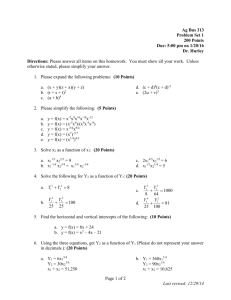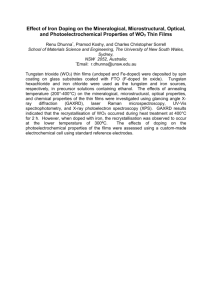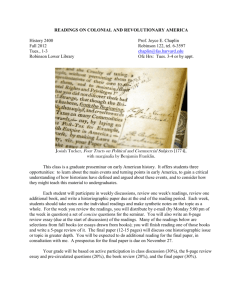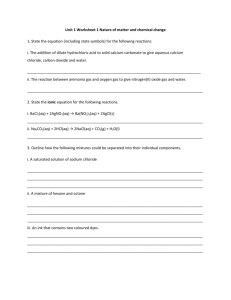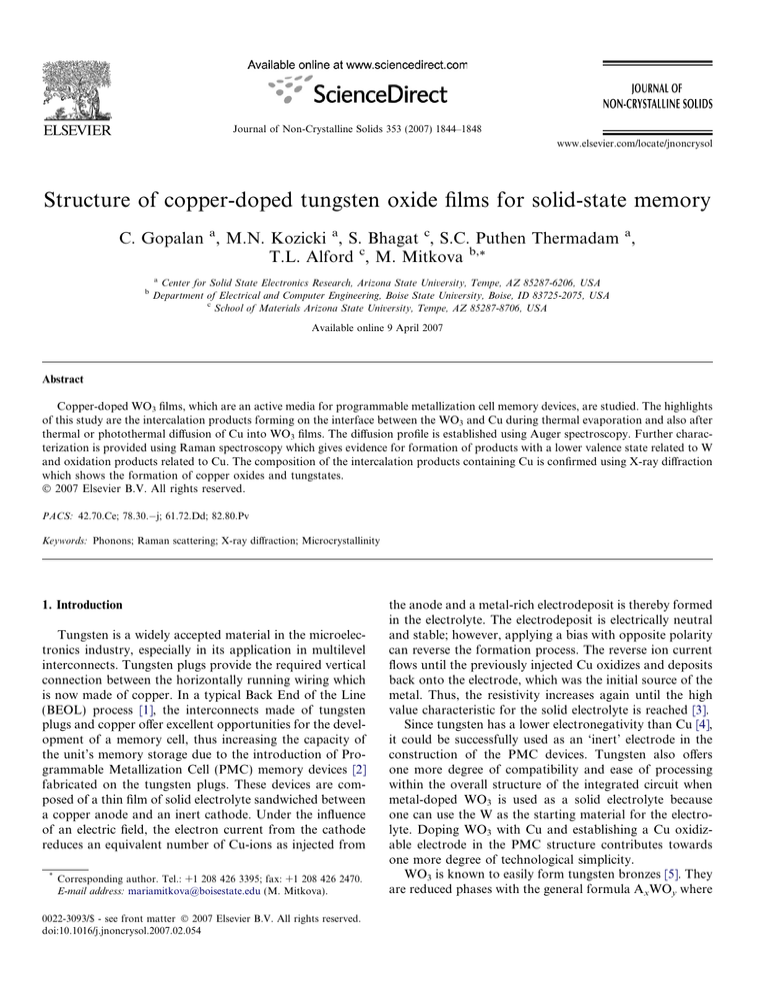
Journal of Non-Crystalline Solids 353 (2007) 1844–1848
www.elsevier.com/locate/jnoncrysol
Structure of copper-doped tungsten oxide films for solid-state memory
C. Gopalan a, M.N. Kozicki a, S. Bhagat c, S.C. Puthen Thermadam a,
T.L. Alford c, M. Mitkova b,*
b
a
Center for Solid State Electronics Research, Arizona State University, Tempe, AZ 85287-6206, USA
Department of Electrical and Computer Engineering, Boise State University, Boise, ID 83725-2075, USA
c
School of Materials Arizona State University, Tempe, AZ 85287-8706, USA
Available online 9 April 2007
Abstract
Copper-doped WO3 films, which are an active media for programmable metallization cell memory devices, are studied. The highlights
of this study are the intercalation products forming on the interface between the WO3 and Cu during thermal evaporation and also after
thermal or photothermal diffusion of Cu into WO3 films. The diffusion profile is established using Auger spectroscopy. Further characterization is provided using Raman spectroscopy which gives evidence for formation of products with a lower valence state related to W
and oxidation products related to Cu. The composition of the intercalation products containing Cu is confirmed using X-ray diffraction
which shows the formation of copper oxides and tungstates.
2007 Elsevier B.V. All rights reserved.
PACS: 42.70.Ce; 78.30.j; 61.72.Dd; 82.80.Pv
Keywords: Phonons; Raman scattering; X-ray diffraction; Microcrystallinity
1. Introduction
Tungsten is a widely accepted material in the microelectronics industry, especially in its application in multilevel
interconnects. Tungsten plugs provide the required vertical
connection between the horizontally running wiring which
is now made of copper. In a typical Back End of the Line
(BEOL) process [1], the interconnects made of tungsten
plugs and copper offer excellent opportunities for the development of a memory cell, thus increasing the capacity of
the unit’s memory storage due to the introduction of Programmable Metallization Cell (PMC) memory devices [2]
fabricated on the tungsten plugs. These devices are composed of a thin film of solid electrolyte sandwiched between
a copper anode and an inert cathode. Under the influence
of an electric field, the electron current from the cathode
reduces an equivalent number of Cu-ions as injected from
*
Corresponding author. Tel.: +1 208 426 3395; fax: +1 208 426 2470.
E-mail address: mariamitkova@boisestate.edu (M. Mitkova).
0022-3093/$ - see front matter 2007 Elsevier B.V. All rights reserved.
doi:10.1016/j.jnoncrysol.2007.02.054
the anode and a metal-rich electrodeposit is thereby formed
in the electrolyte. The electrodeposit is electrically neutral
and stable; however, applying a bias with opposite polarity
can reverse the formation process. The reverse ion current
flows until the previously injected Cu oxidizes and deposits
back onto the electrode, which was the initial source of the
metal. Thus, the resistivity increases again until the high
value characteristic for the solid electrolyte is reached [3].
Since tungsten has a lower electronegativity than Cu [4],
it could be successfully used as an ‘inert’ electrode in the
construction of the PMC devices. Tungsten also offers
one more degree of compatibility and ease of processing
within the overall structure of the integrated circuit when
metal-doped WO3 is used as a solid electrolyte because
one can use the W as the starting material for the electrolyte. Doping WO3 with Cu and establishing a Cu oxidizable electrode in the PMC structure contributes towards
one more degree of technological simplicity.
WO3 is known to easily form tungsten bronzes [5]. They
are reduced phases with the general formula AxWOy where
C. Gopalan et al. / Journal of Non-Crystalline Solids 353 (2007) 1844–1848
A is typically an alkali metal but can also be some other
electropositive metal, and x is less than 1. In the case of
thin films, the structure is not as well organized as in crystals where specific tunnels exist [5] but niches and channels
are still available where metal and in particular Cu atoms
could be accommodated. Scientific and technological interest towards WO3 films stems also from the fact that they
possess electro- and photo-chromic effects [6]. It is believed
that photochromism can be explained by the doublecharge-injection model [7]. By the injection of H ions and
electrons into a WO3 lattice, a tungsten bronze structure
(HxWOWO3, 0 < x < 1) is formed and then W6+ is partially reduced to W5+ in tungsten oxide hydrate or W4+
in 12-tungstates by electrons occupying the empty W5d
orbital due to the electron localization effect. In the presence of electronegative metal in the WO3 sublattice, electron injection can be initiated by the metal and this
opens new perspectives into the diffusion mechanism. This
effect has a very important consequence for PMC technology as it suggests that there is a good opportunity to control the process of metallization of WO3 by which the
optimum conductivity of the material for the operation
of the devices can be achieved. This perspective is the driving force for the study reported in this work that is related
to research on the formation of WO3 thin films due to thermal evaporation. It complements our previous research
related to the formation of WO3 films using wet or plasma
oxidation [8] that were applied for the formation of PMC
devices. The present research is related to the creation of
specific doped products using standard thermal doping or
photo-assisted doping to form a solid electrolyte based
on WO3 and characterization of these products using Field
Emission Scanning electron microscopy (FESEM), Auger
(AES) and Raman spectroscopies, as well as X-ray diffraction (XRD).
2. Experimental
The studied films were evaporated on Si wafers covered
with a TiN film which provides a barrier to Cu diffusion
ensuring that Cu diffuses only into the WO3. Sandwiches
of 100 nm each of Cu and WO3 on top of it were evaporated using electron-beam-assisted heating for the thermal
sublimation of high-purity Cu and WO3 pieces produced
by Cerac, and the thickness was controlled using a quartz
crystal monitor. The evaporation rate was 2 Å/s while the
substrates were rotated to ensure uniform coating of the
films.
Two different means of diffusion processes were used: (i)
thermal diffusion, for which a convection oven set at
135 C was used and since the chamber of the oven did
not permit external light to interfere with the process, it
could be considered as a purely thermal diffusion. The temperature was chosen to be 135 C because this coincides
with a number of technological requirements, e.g. this is
the temperature at which the photoresist begins to denature. Hence the treatment time was restricted to 30 min;
1845
(ii) photo-thermal diffusion. To achieve photo-thermal diffusion, a setup involving a commercially available lighting
source of a 500 W tungsten halogen lamp assembly was
used. The temperature was 135 C. Photo-thermal diffusion
was also carried out for 30 min.
The films were characterized using the following methods: (i) The morphology was characterized using a Hitachi
S4700 field-emission scanning electron microscope at an
acceleration voltage of 15 kV and emission current 10 lA.
(ii) AES was carried out in a Physical Electronics SAM
590 scanning Auger microprobe surface analysis system.
Secondary electron excitation was obtained via a 5 kV electron gun with a beam spot size of 0.5 lm. Depth profiling
was accomplished by coordinating the AES analysis with
Ar+ ion gun etching in the sample surface region of interest. (iii) Raman spectra were collected using an Acton
Spectroprobe-275 with a Coherent Ar+/Kr+ ion laser for
providing 488 nm and 514 nm excitation that was detected
with a liquid nitrogen cooled CCD camera. To reveal
details about the different modes that exist, deconvolution
using Lorentzian expressions was carried out. (iv) The
XRD was accomplished with a Philips X’pert MPD diffractometer with Cu Ka radiation k = 1.54 Å). In order to
cover more lateral depth and to collect better signal from
the thin film, the experiment was run at a constant source
angle of 1, while the detector was scanned from 10 to
95. For these particular experiments, the WO3 films were
thicker than 500 nm to prevent the X-ray beam seeing the
underlying Cu film, leading to misleading results.
3. Results
The intercalation process is very easy accessible in this
system as we have established from the AES study of the
films – Fig. 1. Note that the surface of WO3 is where the
measurement begins (from the left side) and the point at
which the Cu concentration saturates can be treated as
the boundary between the WO3 and Cu. It is obvious that
some copper diffusion occurs even during the film preparation and under these conditions some copper appears on
the surface of the WO3 film. A marked difference is noticed
in the profile when Cu is photothermally diffused, indicated
by an almost ‘step-like’ diffusion profile characteristic of
diffusion along a charge front by ionic species. In the case
of thermally diffused Cu, it follows a profile resembling an
error-function, indicating a thermally activated diffusion
from an infinite source of the impurity. Also visible on
the thermal and photo-thermal diffusion profiles is a significant pile up of Cu at the surface.
The Raman spectra of the initial WO3 films are shown in
Fig. 2. The undoped film which was maintained at room
temperature shows a pronounced peak at 926 cm1. The
main peak at 932 cm1 has a shoulder that can be deconvoluted in two peaks at 838 and 729 cm1, tracing their origin
back to the stretching modes of the O–W–O bond. Since
the considered WO3 film is amorphous, the bending mode
of the O–W–O bond is presented with a very wide peak
1846
C. Gopalan et al. / Journal of Non-Crystalline Solids 353 (2007) 1844–1848
100
90
80
C
B
A
Phothermal Diffusion
Thermal Diffusion
As deposited
70
A
60
% Cu 50
B
40
30
20
C
10
0
Depth in WO3 (arb. units)
Fig. 1. AES depth profile of Cu diffusion in WO3 achieved using thermal and photo-thermal methods.
Fig. 2. Deconvoluted Raman spectra of an undoped WO3–Cu film.
centered at 358 cm1 that is well resolved. The Raman
characteristic of the initial film is also combined with two
peaks at very low wave numbers (139 and 205 cm1) that
are not considered since their nature is questionable – they
could be either related to the lattice vibrations (but in the
given case we are dealing with quite disordered material
so that the probability for this is low), or with some interaction of the laser light with surface species.
The Raman spectrum of the photo thermally treated
sample shows similar features as seen from Fig. 3 considering the W@O mode and the stretching and bending mode
of the O–W–O bond. However in this case, modes at 423
and 642 cm1 appear, which are the breathing modes of
the Cu–O bonding, thus indicating the straightforward nature of the diffusion products as being oxidized copper.
When Cu is introduced in the WO3 matrix due to thermal diffusion, Fig. 4, the mode at 643 cm1 is well resolved
and a new wide mode at 511 cm1 appears – both of them
related to Cu–O bonding. The mode at 292 cm1 grows
substantially compared to the previous cases and at the
same time the mode at 358 cm1 becomes very weak and
Fig. 3. Deconvoluted Raman spectra of a WO3 film photothermally
doped with Cu.
Fig. 4. Deconvoluted Raman spectra of a WO3 film thermally doped with
Cu.
the mode at 729 cm1 that is seen in the previous cases does
not exist.
C. Gopalan et al. / Journal of Non-Crystalline Solids 353 (2007) 1844–1848
*
Intensity (Arb. units)
+
*
^
20
#
o
(a)
*
^
o
(b)
#
>
+-
^
>
+-
*
*
o
#
40
60
2 Theta (Deg.)
(c)
*
*
*
*
80
Fig. 5. XRD patterns of (a) the initial film; (b) the photo-thermally
diffused film; (c) the thermally diffused film. The following signs are
assigned for the different components: + for WO3; for WO2; * for Cu; ^
for CuWO4; v for Cu2WO4; for Cu3WO6; # for CuO.
The XRD data shown in Fig. 5 give some more information about the particular compositions appearing. The
WO3 compositions were predominantly amorphous. The
characteristic peaks related to these products form a rather
wide peak situated around 2h 23–280 in which the most
intense peaks of WO3 (JCPDS card 32-1395) and WO2
(card 32-1393) are situated. Among the diffusion yield we
identified Cu (card 89-2838); CuO (78-0428); Cu2WO4
(78-0928); CuWO4 (70-1732) and Cu3WO6 (83-6950).
Using the Scherrer equation, we calculated the grain size
of the diffusion products which were crystalline and form
a hetero-phase within the WOx matrix. There is a large dispersion in size distribution, ranging from 5 nm to 90 nm
with an average size of 20 nm.
4. Discussion
When we discuss the structure and the condition of the
as evaporated WO3 film it is to be noted that the vapor produced by heating WO3 does not consist of individual atoms
but is molecular in nature. The dominating species are trimeric W3O9 molecules. Their condensation organization is
complicated and highly dependent on the experimental
conditions. The undoped film which was maintained at
room temperature shows in the Raman spectrum a pronounced peak at 926 cm1 as seen in Fig. 2. This is considered to be the result of the stretching mode of a W@O
terminal bond. Daniel et al. [9] argue that this mode could
be assigned to a longitudinal optic mode of the W–O bond
in the bulk WO3 material. However, it is more convincing
that this mode is related to the W@O terminal structures
since it is the strongest bond in the system and these are
thin films with a very high surface-to-volume ratio. This
mode appears at a lower wave number than what is usually
reported in the literature – for example, the closest data for
a three-dimensional network is 945 cm1 [10]. This can be
1847
explained with the influence caused by the Cu atoms diffusing in the films during film preparation – Fig. 1 and by
means of the fact that the films were prepared via vacuum
evaporation and hence are free of water of crystallization
whereas usually, the Raman data reported consider WO3
obtained by wet methods. Decreasing water of crystallization content leads to a gradual shift towards shorter wave
numbers as shown in [11] where 960 cm1 has been
reported for WO3 Æ 2H2O, with 948 cm1 for WO3 Æ H2O,
and 945 for samples with 1/3 H2O [11].
As revealed by the XRD data, metallic Cu is registered
in this film whose presence is also confirmed by the Auger
spectroscopy. One can barely observe Cu in the Raman
data, because its occurrence results in a very weak signal,
though on the XRD pattern it gives very well resolved
sharp peaks because Cu appears in a crystallized and more
organized form than the evaporated WO3. Note that even
during the evaporation and double film formation Cu
reacts with the surrounding WO3, oxidizes and forms tungstates. These reactions are possible because of the high
kinetic energy with which the WO3 molecular fragments
condense. The cross section profile is indicative of a chemical interaction occurring at the Cu–WO3 interface.
The photo-thermally treated sample shows similar features as seen from Fig. 5 considering the W@O mode
and the stretching and bending mode of the O–W–O bond.
However these modes are shifted farther towards shorter
frequencies, which is an indication of some shortening of
the bonds. We attribute this to some distortion of the
bonds caused by the diffused species in the film. It is
known that, for amorphous films, the width of the Raman
spectra could be used as an indication of the degree of
ordering of the system. Since there are no significant
changes to the mode features, we suggest that the process
of photo-thermal treatment and diffusion of Cu into the
WO3 films does not contribute towards crystallization or
higher order of the host film. The nature of the diffused
species is fairly straightforwardly related to vibrations
coming from the CuO lattice, as they appear at frequencies
of 423 and 642 cm1. We consider the process of Cu
photodiffusion into WO3 as a two-step process by which
the Cu initially penetrates into the bulk of WO3 and takes
part in an electron-exchange reaction and oxidizes to form
CuO and a number of Cu-tungstates, as indicated also by
XRD analysis. It then mixes within the WO3 structure and
forms a hetero-structure. We suggest that this process generates charged defects that can be attributed to the photoinduced changes in the WO3 matrix under illumination.
The peaks related to pure Cu reveal formation of smaller
crystals compared to the initial film contrary to the peaks
related to the oxide and tungstates for the formation of
which part of the pure Cu is consumed during the
diffusion.
The reduction-oxidation process on Cu insertion is even
more profound when Cu is introduced in the WO3 matrix
as a result of thermal diffusion. As shown in Fig. 4, there
are two specific signs for this process: (i) on one side the
1848
C. Gopalan et al. / Journal of Non-Crystalline Solids 353 (2007) 1844–1848
mode at 643 cm1 is better resolved than in the case of
photo-thermal diffusion and a new wide mode at
511 cm1 develops; (ii) The other indication for the redox
diffusion process taking place is the growth of the mode
at 292 cm1 that is related to the appearance of a higher
amount of W5+. That the O–W–O bending mode at
358 cm1 becomes very weak and the O–W–O stretching
mode at 729 cm1 practically disappears, pointing to a
decrease of the availability of W6+ in the films. These features are may be characteristic for the mixed valency of the
Cu3+–Cu2+ dispersed in the WO3 matrix [12], evidence for
which we have found at the XRD data – Fig. 5. The WOx
peak area becomes reduced. The Cu peak follows the same
trend. That indicates that Cu is reacting with WOx. There
is obvious loss of crystallinity because of the reaction and
formation of a number of metastable tungstates. Oxidation
of Cu and formation of Cu oxides and salts always seems
to accompany its introduction in oxide systems, as for
example this effect occurs in an SiO2 matrix when Cu is
introduced in it at higher concentration at moderate temperatures [11] where Cu oxides and silicates form. XRD
data indicate some shift of the center of the peak characteristic of the WOx towards higher 2h values which are characteristic of WO2 that could be considered as a sign for the
formation of W4+ – Fig. 5 (ref. to JCPDS card 32-1393).
The relative effects from the appearance of different
phases are in good accordance when we regard the results
of all the characterization methods used. The wide variety
of products forming affects in a corresponding way the
electrical features of the systems and hence the performance of the PMC devices based on them.
5. Conclusions
The main results of our work can be summarized as
follows:
• We have shown evidence that the formation of sandwiches from Cu and WO3 using thermal evaporation
results in intercalated structures.
• The diffusion profile of Cu in WO3 is strongly dependant
upon the diffusion driving forces and related with them
charge effects; Cu piles up on the surface of the WO3
films because of kinetic effects during diffusion.
• The diffusion process is in essence oxi-reductive in nature, resulting in different structures, depending upon
the method by which the diffusion is realized. However,
the newly formed medium is heterogeneous.
• There is a big dispersion in the size of the diffusion products that we obtained but the fact that some of them are
quite small is encouraging and is a challenge for establishing a good control of the size of the diffusion
products.
• In general the results obtained give a global perspective
about the strongly promising structures based on WO3–
Cu sandwiches as medium for preparation of PMC
memory devices.
References
[1] S. Wolf, Silicon Processing for the VLSI Era, vol. 4, Lattice Press,
Sunset Beach, CA, 2002, p. 674.
[2] M.N. Kozicki, M. Mitkova, C. Gopalan, M. Balakrishnan, ‘‘Programmable structure including an oxide electrolyte and method of
forming programmable structure’’. US Patent 7,101,728 (2006).
[3] M.N. Kozicki, M. Park, M. Mitkova, IEEE Trans. Nanotechnol. 4
(2005) 331.
[4] L. Pauling, The Nature of the Chemical Bond, Cornell University
Press, 1960.
[5] A. Simon, J. Ravez, Compt. Rend. Chim. 9 (2006) 1268.
[6] C.G. Granquist, Handbook of Inorganic Electrochromic Materials,
Elsevier, New York, 1995.
[7] B.W. Faughnan, R.S. Grandall, P.M. Heyman, RCA Rev. 36 (1975)
177.
[8] M.N. Kozicki, C. Gopalan, B. Malakrishnan, M. Mitkova, IEEE
Trans. Nanotechnol. 5 (2006) 535.
[9] M.F. Daniel, B. Desbat, J.C. Lassegues, B. Gerand, M. Figlarz, J.
Solid State Chem. 67 (1987) 235.
[10] H. Rosen, E.M. Engler, T.C. Strand, V.Y. Lee, D. Bethune, Phys.
Rev. B 36 (1987) 726.
[11] F. Perez-Robles, F.J. Garcia-Rodriguez, S. Jimenez-Sandoval, J.
Gonzalez-Hernandez, J. Raman Spectrosc. 30 (1999) 1099.
[12] D.B. Hibbert, J.R. Melrose, Phys. Rev. A 38 (1988) 1036.

